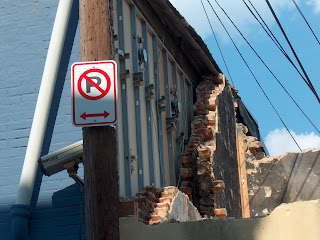Party wall law began
in England, in response to problems that arose when individual row houses were
demolished leaving adjacent homes, inadequately supported. The beauty of row
home construction was economy of scale and maximal land use, at the turn of the
century. Row houses were built in such a way that each shared walls with a
neighbor on either side except for the end units, which had only one shared
wall. Shared walls were never a problem until of course they were no longer
shared.
(source unknown)
Many row houses were
constructed as rental housing for workers. They were not always well built and
many were very poorly maintained. So, it was not surprising to encounter homes
that had deteriorated to the point of collapse, in the middle of a row of homes.
When these neglected and abused homes were demolished, unless the intrinsic
weakness of the shared wall was recognized and adequately supported, both of
the neighboring houses were immediately at risk of collapse. It became a house
of cards. Laws and codes were written to protect both parties since each had a
stake in what happened to “their” wall. It was like a three-legged race. What
happened to one, affected the other.
Baltimore row houses
Baltimore is famous
for its many late 1800’s worker row houses, which are very similar to those in
England. Today sadly, one can see many examples of buildings in the middle of a
row of Baltimore homes, burnt out and starting to collapse through neglect and
abuse. This is classic urban decay. Perhaps these are fallow fields simply
awaiting a natural death and the bulldozers of development. Who knows?
The author has
concluded, from “walking around observation” of various local building
disasters, that on each occasion the cause was lack of knowledge and understanding
of party wall principles – essentially construction incompetence. The construction
complications shown in Figures 1 and 2 were entirely preventable.
(Figure 1.) Durr
Alley construction project where the neighboring wall was not underpinned
adequately prior to excavation of the basement of the home.
(Figure 2.a) Naylor Court construction project where the stable at 1316 9th Street rear proved to be so solid, that in the process of its destruction, the literal “party wall” in VIP Lounge in the nightclub next to it (now the MOOD Lounge) was breached, exposing speakers and dry wall.
(Figure 2.b) The raze permit had been issued based on the premise that the stable was falling down. In fact it was actually rather difficult to tear down!
(Figure 2.c) The "unstable" Lincoln era stable had been quite stable.
Some principles of American party wall
law.
- Each person owns as much of a party wall as is situated on (their) land.
- Each owner acquires title to one-half the wall and an easement for its support as a party wall in the other half.
- A party wall that is constructed without any reference to a time limitation implies permanency.
- A party wall is for the mutual benefit and convenience of both owners. Each adjoining owner has the right to its full use as a party wall in the improvement and enjoyment of his property. Neither owner can use the wall in a manner that impairs the other's easement or interferes with his or her property rights.
- Either party can replace a party wall that is dangerous to life or property or insufficient for the support of existing buildings.
- Neither owner has any right to have a dangerous wall bolstered by allowing it to rest upon, or be sustained by, the timbers, walls, or parts of the other's building.
Vol. 55 No. 52 Part 3 District of
Columbia Register Dec 26 2008
Section 3307A
Protection of Adjoining Property
3307.2 Notification required
The person
causing the work shall provide written notice, and a copy of the proposed work
plan, to the owner of the adjoining property advising said owner of the
intended work and the need for protection for the adjoining property.
4. If the
adjoining owner affirmatively denies permission, the adjoining owner shall
provide justification to the code official indicating the reason for the
denial. Upon granting permission, conditional or unconditional, the adjoining
owner shall notify the code official and the person causing the work in
writing.
3307.2.1 Underpinning party walls. In the case of existing adjoining or
party walls, which require underpinning, proper underpinning shall be provided
in accordance with applicable sections of this code whether or not written
permission to enter the adjoining lot is granted.
District of
Columbia Municipal Regulations Title 10A Historic Preservation
Functions of the Mayor’s Agent
104.5 (page 13)
The Mayor’s Agent determines if historic landmarks or contributing
buildings in historic districts are threatened by demolition by neglect*, and
pursues appropriate remedies pursuant to the Act.
(a) This authority may be
exercised by the Historic Preservation Office under the supervision of the
Mayor’s Agent.
(b) The Historic Preservation Office may
pursue enforcement remedies with the assistance of the Office of the
Corporation Counsel, the Department of Consumer and Regulatory Affairs, or
other agencies as appropriate.
* Demolition by neglect: Neglect in maintaining, repairing, or securing a historic landmark
or a building or structure in a historic district that results in deterioration
of an exterior feature of the building or structure or the loss of the
structural integrity of the building or structure (D.C. Official Code §
6-1102(3A) (2002 Supp.)).







1 comment:
I took a lot of photos in this town, so I'm going to break them down into two posts.
Bellevue Stucco
Post a Comment